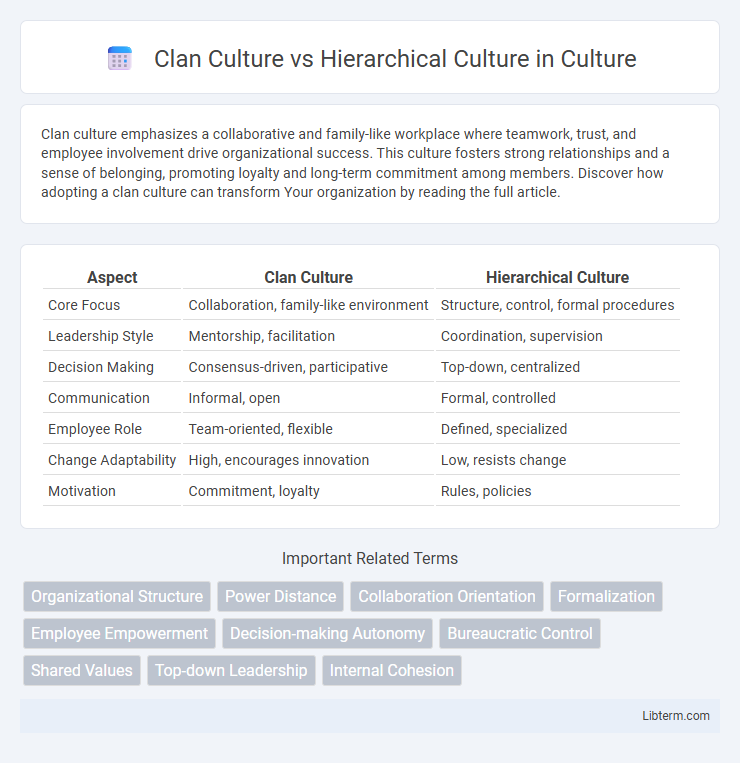Clan culture emphasizes a collaborative and family-like workplace where teamwork, trust, and employee involvement drive organizational success. This culture fosters strong relationships and a sense of belonging, promoting loyalty and long-term commitment among members. Discover how adopting a clan culture can transform Your organization by reading the full article.
Table of Comparison
| Aspect | Clan Culture | Hierarchical Culture |
|---|---|---|
| Core Focus | Collaboration, family-like environment | Structure, control, formal procedures |
| Leadership Style | Mentorship, facilitation | Coordination, supervision |
| Decision Making | Consensus-driven, participative | Top-down, centralized |
| Communication | Informal, open | Formal, controlled |
| Employee Role | Team-oriented, flexible | Defined, specialized |
| Change Adaptability | High, encourages innovation | Low, resists change |
| Motivation | Commitment, loyalty | Rules, policies |
Understanding Clan Culture: Definition and Key Features
Clan culture emphasizes a family-like environment where collaboration, trust, and employee involvement are prioritized to foster loyalty and morale. Key features include strong internal focus, flexibility, shared values, and a commitment to mentoring and teamwork. This culture type is often seen in organizations that value employee development and open communication over rigid structures.
Defining Hierarchical Culture: Main Characteristics
Hierarchical culture is characterized by a structured and formalized work environment where roles, responsibilities, and procedures are clearly defined to ensure stability and efficiency. Decision-making authority is centralized, with strict adherence to rules and policies to maintain order and control within the organization. Emphasis on consistency, predictability, and accountability distinguishes hierarchical culture, often found in government agencies, large corporations, and military institutions.
Core Values: Collaboration vs. Control
Clan Culture emphasizes core values of collaboration, teamwork, and employee involvement, fostering a family-like environment where trust and loyalty drive organizational success. Hierarchical Culture prioritizes control, structure, and formalized procedures, ensuring consistency, efficiency, and clear authority lines to maintain order within the organization. These differing core values shape decision-making processes and impact overall organizational agility and employee motivation.
Leadership Styles in Clan and Hierarchical Cultures
Leadership styles in clan cultures emphasize collaboration, mentorship, and participative decision-making, fostering a family-like environment that prioritizes employee engagement and loyalty. In contrast, hierarchical cultures rely on formal authority, clear roles, and top-down communication, with leaders focusing on control, efficiency, and adherence to established procedures. These distinct leadership approaches significantly influence organizational dynamics, with clan leaders encouraging flexibility, while hierarchical leaders enforce structure and consistency.
Communication Patterns and Employee Interaction
Clan culture emphasizes open, informal communication and strong interpersonal relationships, fostering collaboration and mutual support among employees. Hierarchical culture relies on formal communication channels, structured roles, and top-down information flow, which can limit spontaneous interactions but ensure clarity and consistency. Employee interaction in clan cultures is more personal and participatory, while hierarchical cultures maintain professional distance and adherence to authority.
Decision-Making Processes: Consensus vs. Authority
Clan Culture emphasizes decision-making through consensus, fostering collaboration and collective input to ensure team alignment and commitment. Hierarchical Culture relies on authority-based decisions, where leaders or managers follow established protocols and chain-of-command structures to maintain order and consistency. The consensus approach in Clan Culture enhances adaptability and employee engagement, whereas Hierarchical Culture prioritizes efficiency and control in decision implementation.
Impact on Employee Motivation and Job Satisfaction
Clan culture fosters high employee motivation and job satisfaction by emphasizing collaboration, support, and a family-like atmosphere that encourages trust and loyalty. Hierarchical culture, with its structured rules and clear authority lines, can reduce motivation by limiting autonomy and creativity, often leading to lower job satisfaction. Employees in clan cultures typically experience greater engagement and commitment compared to those in hierarchical settings.
Adaptability and Innovation in Both Cultures
Clan culture emphasizes adaptability through collaborative decision-making and open communication, fostering an environment where innovation thrives via collective creativity and employee empowerment. Hierarchical culture, characterized by structured procedures and clear authority lines, tends to resist rapid change but can drive innovation through systematic problem-solving and formalized processes. Both cultures impact adaptability and innovation differently, with clan culture promoting flexibility and hierarchy ensuring consistency in implementing new ideas.
Organizational Performance and Productivity Comparison
Clan culture, characterized by collaboration, employee involvement, and a family-like environment, often enhances organizational performance by fostering innovation, job satisfaction, and team cohesion. Hierarchical culture emphasizes formal structure, control, and clear procedures, which can improve productivity by ensuring consistency, efficiency, and risk management. Studies indicate that organizations with clan cultures tend to excel in dynamic, creative industries, while hierarchical cultures perform better in stable, process-driven environments, impacting overall productivity and adaptability differently.
Choosing the Right Culture: Factors for Business Success
Choosing the right culture between Clan Culture and Hierarchical Culture depends on factors such as organizational goals, employee engagement, and adaptability requirements. Clan Culture fosters collaboration, employee involvement, and flexibility, making it ideal for innovative and customer-focused businesses. Hierarchical Culture emphasizes structure, clear roles, and consistency, supporting stability and efficiency in large or regulated organizations.
Clan Culture Infographic

 libterm.com
libterm.com